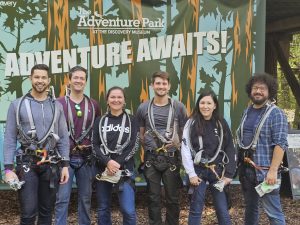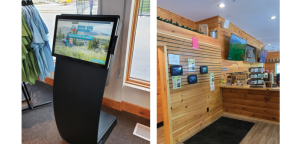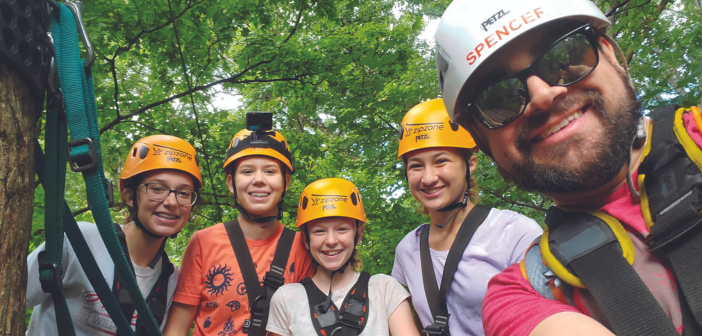For decades, amusement parks have offered photos that allow guests to relive the most exhilarating moment of their day. Images of friends on a roller coaster, hands raised over their heads, mouths wide open in fear and exhilaration have been a staple of the experience since the 1980s. Now, many adventure park patrons have the same expectations.
“For people doing zip lines and aerial adventure courses, there’s almost an expectation that there’s going to be a photography or video component,” says Nate Pfefferkorn, owner of Action Photo Systems, which offers automatically triggered photo and video systems. “If there’s not one, they’re kind of bummed.”
To this end, aerial adventure parks and zip tours have strived to follow a similar model as amusement parks, albeit with new goals and challenges. Now, new technologies and expanded options for digesting digital media have given park operators even more to consider.
To Sell or Not to Sell?
Operators have mixed opinions about the value of offering photos to guests, with some seeing it as an additional source of income and others viewing it as an invaluable marketing tool that should be provided for free.
According to Ryan O’Grady, CEO of Fotaflo, a software company that helps operators get photos into the hands of their customers, parks need to weigh the two options.
Photos gratis. “If you can get 50,000 customers through the door regardless and want to maximize your per-head take on every customer, you should be selling photos,” says O’Grady. “But if referrals and repeat [customers]are more important to you, we recommend giving them away.”
O’Grady encourages many of his clients to give photos away. He cites a 2023 Fotaflo study that indicated more than 41 percent of traffic to Saskatchewan adventure park Treeosix’s website was generated through photo sharing. And with the rising influence of social media over the last decade, it’s tough to assign a numerical value to endless shares and tags.
Marketing and revenue. Neal Belovay, co-founder and CEO of PicThrive, a photo and video sales and marketing platform, sees photo and video sales as “the holy grail in tourism: a high margin revenue stream with guest-driven marketing through photos and videos.”
But, to understand whether you can generate revenue and marketing from your photos, says Belovay, “you first need to determine if you can reliably capture content that guests can’t get themselves.
“Guests are savvy,” he adds, “they’re not going to spend their money if you’re not providing value.”
Technology
The selling-vs-gifting debate isn’t the only thing operators are grappling with. They must also sort through several available methods and technologies for photo sharing, each with their own benefits and challenges.
Unlike amusement parks, where automatic camera systems are often installed at specific points on roller coasters and log flumes, aerial adventure operations don’t have a one-size-fits-all solution. Many would-be photo sites are remote, with minimal infrastructure available. Harsh weather, staffing issues, and the complexities of capturing people at the right moment also play a role in how photos are captured.
When aerial adventures began gaining traction in North America in the 2010s, many experimented with stationing dedicated photographers around the park, photographing groups posing in harnesses and making their way through courses. These photographers could move around, shooting in remote areas where zip lines are located, and interacting with guests to capture the best photos possible. At the end of the day, guests would receive an SD card with unedited images that would often end up in a junk drawer. Additional struggles with staffing, reliability, and consistency drove many operators to implement self-triggering cameras, or software-based systems that allow park guides or a photographer to shoot guest photos.
Today, operators have found success with different iterations of camera technology, depending on their needs and priorities. Two common technologies are automated self-triggering camera systems and software that relies on guides to shoot photos with smartphones or DSLR cameras.
Automated camera systems. For Pfefferkorn, benefits of automated systems include that they don’t require additional staff nor that existing staff take on additional tasks, that there are few ongoing costs, and that they produce consistent high-quality images.
“The two shots that guests want are them riding the zip line and a group selfie with their family or friends,” says Pfefferkorn. “So, we typically [install]an action camera on a zip line that’s triggered as they go by and then we do a selfie station that either the guide or guest trigger on a suspension bridge, platform, or somewhere scenic.”
Still, there are considerations before implementing an automated camera system, including where to install, infrastructure, and upfront costs.
The cost to install an automated camera system, for example, varies depending on the configuration, number of cameras, number of sales kiosks, and infrastructure required, but generally ranges from $25,000 to $100,000. With Action Photo Systems, some operators opt to revenue share from photo sales in exchange for a minimal markup on equipment installation, and others pay a monthly fee to use the software and technology without revenue sharing. Aside from the initial investment, a recommended annual maintenance visit, and either the monthly fee or percentage of photo sales, ongoing costs are minimal, says Pfefferkorn.
But for some aerial adventures, implementing one of these systems can be a challenge. Not only does each camera location need power, which can be achieved through solar generators or battery banks in remote locations, but there can be struggles with cameras that are mounted permanently in harsh climates, despite often being contained in weatherproof containers. Periodic maintenance and clearing of the cameras can be a solution, but operators must weigh this depending on their location and available resources. And then, of course, is the issue of connectivity, which is required for transferring and delivering photos.
Software solutions. Some operators have found that self-triggering cameras installed on zip lines can yield less-desirable images than those achieved by manual shooting. “It’s like my eyes are closed in every picture on every tour I’ve ever been on that uses a stationary camera,” says Treeosix CEO Jori Kirk.
After Kirk had Treeosix guides take photos with their smartphones and upload them onto jump drives during the park’s first year, the park has now found success using Fotaflo software that taps into the park’s booking system to send photos taken by guides to the guests.
The software automatically sends periodic reminder emails to guests, driving them back to the website and encouraging them to re-share photos from their experience for years to come. Fotaflo removes itself from these emails, so the interaction is only between the guest and operator.
“A dedicated photographer (e.g., a guide, a staff photographer, or even a third-party photographer) can make your guests feel seen,” says PicThrive’s Belovay. “They receive a personalized photography experience with higher quality shots, giving their adventure stories an edge.”
While having guides add photography to their daily to-do list can seem like a cumbersome task, Lori Pingle, owner of Ohio’s ZipZone Outdoor Adventures, which uses Fotaflo software, has found an upside to this approach.

In lieu of using a photo service, Outdoor Ventures hangs branded banners at its parks to use as “selfie stations.”
“The generation of people who now work for us sometimes has a bit more trouble creating conversations and relating to guests on the tour,” says Pingle. “But having staff take the pictures gives them a tool for conversation. They can say, ‘hey, you guys get together so we can take a picture.’ And that’s a few moments less that they need to make small talk.”
This interaction, and the opportunity for guides to show their guests the photos, creates a rapport that can ultimately result in better tips, adds Pingle, which helps with staff buy-in.
“Not only does it improve the experience for guests and make them happier, but our staff gets better tips because they’re also the personal photographer,” she says. “It’s a win-win.”
Some operators opt to pay guides, photographers, and/or sales staff a commission on their photo sales, another “win-win” as Belovay calls it. “Your staff can also earn more via commissions without increasing your costs,” he says. “This makes it easier to recruit and retain top talent.”
The initial investment for Fotaflo software is minimal when compared to automated systems, with several different plans available ranging from $89 per month to $11,868 per year depending on features and number of locations. Other than smartphones for the guides, no hardware or infrastructure is required, and only a one-hour remote meeting is needed to get everything set up.
PicThrive’s platform is transaction based, with operators charged a fee per album sold. Guests can purchase photos in-store through the operator’s POS system or online via a PicThrive-hosted POS system, with fees varying based on purchase method. Again, there’s no infrastructure needed to use the platform, but Belovay does encourage operators to invest is digital cameras.
“Our customers see significant media sales increases after switching from smartphones to DSLRs,” says Belovay. “DSLR photos offer higher quality, better resolution, and perform well in dynamic environments like sports photography. Using a DSLR also projects professionalism, enhancing your brand image.”
Selfie stations. Some operators haven’t found success with either of these solutions, opting instead for a simple “selfie station” in which guests can take their own photos in front of a branded banner.
“The problem we found is that everyone thinks they want a picture of themselves zip lining,” says Outdoor Ventures founder and CEO Bahman Azarm. “But when they are zip lining, they’re not in a great position. The person doesn’t look great.”
Initially, Azarm utilized professional photographers in his eight parks, but found an inconsistency in photo quality as well as many unpurchased prints. He tried several automated systems but didn’t see much of a return on the investment. And with most of the experiences being self-guided, even a combination of automated systems and guides shooting photos didn’t quite meet his needs.
In the end, he settled on a large, $500 branded banner in front of which guests take “selfies” at each of his locations.
“Most people still have all the gear on—the harnesses and clips and everything—and they feel excited about doing the activity,” says Azarm. “They really want to take a picture and show it off, so then they post it on Facebook or Instagram.”
Azarm likes to replace the banner annually to ensure it looks good in every photo, a small price to pay for the otherwise free promotion he gets out of his guests.

The Fotaflo platform sends photos to guests’ mobile devices for easy sharing; Guests scan a printed QR code to reach a Viewpoint Videos landing page where they can preview and buy their video.
Evolutions in Web-Based Media
Like most industries, the needs of and technology available to aerial adventure operators are constantly changing. From the prints provided by professional photographers to the nearly immediate transfer of digital images on social media platforms, photo technology has evolved significantly over the past decade-plus.
Video technology. More recently, with social media algorithms changing to favor those who post more interactive media, videos have become an offering worth considering.
“It’s a more engaging media,” says Casey Dixon, vice president of sales for REVL, which offers automated video systems. “With photos, you look at it once and then move on, whereas with a video, you can capture some funny moments that might turn viral. Every social media [platform]like TikTok, Snapchat, and even Instagram is now geared towards video.”
Dixon sees video as an additional revenue stream rather than a free marketing tool, but with the popularity of video content on social media, the benefits are twofold.
The initial investment for a REVL video system can range from $2,000 to $12,000, according to Dixon, and covers a server that does the editing, docking stations that pull footage off cameras, and self-service kiosks for purchase, if necessary.

An Action Photo Systems touchscreen sales kiosk at Snow King, Wyo.; Guests at Legacy Mountain Ziplines, Tenn., can search and purchase photos from wall mounted PicThrive kiosks.
Artificial intelligence. In the past, operators utilized GoPros that guests would use to film point-of-view (POV) videos they could later purchase on an SD card. But often, the guests would get home to find out they never turned the camera on, turned it on at the wrong time, or best-case scenario, have a bunch of raw video content they were unsure what to do with.
Now, with the help of artificial intelligence (AI), REVL offers a solution that provides visitors with a finished, edited product that blends the guest’s POV video footage with stock footage.
AI, which has improved significantly even in the last year, is being used for photo editing, too. Companies like Fotaflo utilize AI to edit images, creating consistent photographs that get delivered to guests almost immediately without any manual work.
Pfefferkorn, whose company is currently using RFID, or a barcode scanner, to deliver photos sees a future industry in which AI can do even more.
“We’re using AI for image enhancement, and it’s gotten way better just in the last year,” he says. “I expect there to be continued advancements in the facial recognition. Maybe the software can automatically determine who the person is and how to get the images to them.”
Of course, “We’re still trying to figure out whether or not people really want that,” Pfefferkorn adds. “Is it creepy?”
Creepy or not, it’s inevitable that technology—AI and other—will continue to evolve, and operators will have to figure out how to adapt and get the most out of the photo and video content available to their parks, both for their customers’ expectations and their own bottom line.







